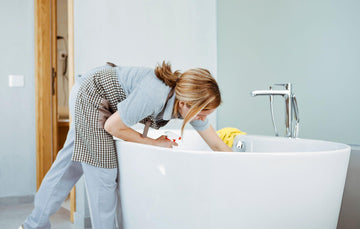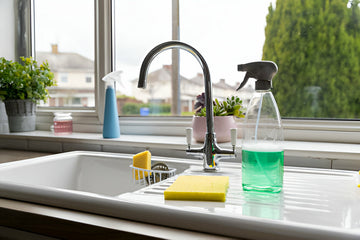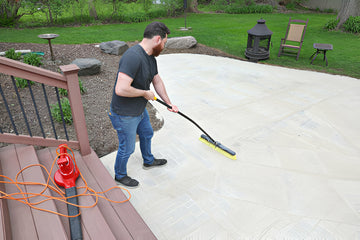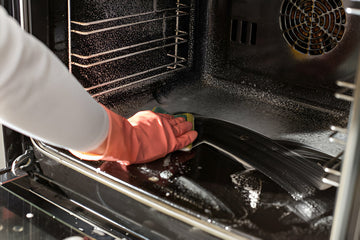Laminate floors are one of the most popular flooring types that mimic the look of hardwood floors for a more affordable price. They are cherished for their longevity and low-maintenance properties. Laminate flooring is made from many layers that are bonded together through lamination. The outermost layer is transparent, protecting the fabric against staining and fading. Beneath this layer is a photographic overlay miming the look of wood grain or other more natural textures.
Now, how do laminate floors differ from wood floors? Unlike other wood flooring types, laminate floors need not be polished or refinished, making them affordable and easy to maintain, especially in large households. It is suggested that they should be sturdy, yet they can easily be damaged by water or get scratched.

What are Common Challenges in Cleaning Laminate Floors
It goes far beyond sweeping and mopping to make the laminate floors look new; it calls for knowledge of some factors that affect them. Here are some common issues you might encounter and tips on how to address them effectively:
Sensitivity to Moisture
Laminate floors are especially sensitive to moisture and can be easily damaged if they come into contact with water. This sensitivity can lead to warping or even what is referred to as the bubbling of the flooring panels. It is important to know how to clean laminate flooring without using water. Ensure that you use a damp mop rather than a wet one, and do not allow liquids to stay on the surface. Ensure any drops are wiped with a dry or slightly wet cloth as soon as possible.
Vulnerability to Scratches
Despite being hardwearing, the laminate floor is vulnerable to scratches by furniture, pet claws, or sharp objects. To reduce this risk, put felt pads under furniture and ensure that the nails of the pets are clipped correctly. Soft items such as microfiber mops for day-to-day cleaning should be used because they do not harm the floor's surface. This is the place to find the perfect mop.
Potential for Film Residue
At times, after washing the laminate floor, a slimy layer is formed, and it appears dirty and dull. This problem is usually associated with excess cleaning products or inadequate floor washing. To prevent this, follow the cleaner as instructed and use a clean, damp mop to wash the remaining cleaner. Selecting a vinegar and water solution will also help minimize residue formation because vinegar evaporates without leaving residue on windows.
Knowing these challenges and applying the proper cleaning techniques will make it possible to preserve the looks and durability of the laminate floors.

Tools for Laminate Floor Care
It is important to select the correct tools and products that would assist in cleaning the laminate floors without harming them. Here is the list of appropriate products for cleaning the floor and those that may cause harm.
What are Some Suitable Cleaner Products?
- Multi-Purpose Cleaner: These cleaners are ideal for use on different types of floors and can be used on laminated floors. They assist in washing the floor while avoiding undesirable impacts on the surface finish.
- Laminate Floor Cleaner: Formulated for laminate floors only, these cleaners vary the requirement of the laminate floor and effectively clean without harming the sealer layer.
- Wood Floor Care Products: Many products manufactured on wooden floors are also suitable for laminate floors. They clean gently while preserving the shine and durability of the floor.
Unsuitable Cleaning Tools and Products
Laminate floors are sensitive and can be easily scratched if the wrong cleaning tools are used. Here is what not to use to clean laminate floors:
- Hard-Bristle Brushes: These brushes can scratch the surface of the floor. Soft brushes or cloths should always be used.
- Metal Scouring Pads: Metal pads are as abrasive as hard-bristle brushes and can scratch laminate surfaces, making them unsuitable.
- Rough Cloths or Sponges: These can also scratch the floor. Clothes should be soft and gentle and, if possible, made from microfiber.
- Overly Wet Mops: Water should not accumulate on the laminate floor because it leads to swelling or warping. It is preferred to use mops, which are only slightly damp.
- Overly Acidic or Alkaline Cleaners: Such cleaners can damage your floors by removing the protective layer on them. Avoid using any cleaning products that alter the pH of the water, and only use cleaning products designed for use on laminate floors.
It is possible to maintain the health of the laminate floors by using the right cleaning materials and refraining from using abrasive products.
How to Clean Laminate Floors?
Laminate flooring requires proper cleaning to ensure that its life span, as well as its brightness, is enhanced. You can learn how to clean laminate hardwood floors and make them look fresh using routine cleaning and other effective cleaning methods.
Regular and Deep Cleaning Techniques
- Sweeping and Dusting: The floors should be swept with a soft, bristled broom or a dry mop daily to remove abrasive particles and avoid scratching the floor's surface.
- Using a Microfiber Mop: Carry a 360° Rotating Microfiber Flat Mop available at the store for regular cleaning. This tool is ideal because it does not use water but cleans the dirt just as the floor requires, thus avoiding scratching.
- Spot Cleaning Spills: Spills and stains should be attended to immediately using a damp microfiber cloth with as little pressure on the area as possible.
- Preparing the Area for Deep Cleaning: Inform that vacating the furniture and rugs is necessary to ensure no barriers to accessing the entire floor.
- Selecting the Right Cleaner: Do not use a metal brush; you might need a soft-bristled brush to clean the laminate floors and avoid scratching the protective layer.
- Effective Mopping Techniques to Avoid Residue: Dip your mop into the cleaning solution and ring it out so that it will be wet but not overly wet when you start mopping. Sweep, vacuum, and mop toward the laminate panels while not leaving standing water on the floor.
Specific Cleaning Instructions
Dealing with stains and maintaining non-waterproof laminate flooring requires extra measures and materials. Here is how to clean laminate wood floors from different stains and care for non-waterproof floors using these tips and tricks.

How to Remove Food and Beverage Stains?
Use water and vinegar for most general spills and stains, such as those generated by food and beverages. Mix equal vinegar and water and fill a spray bottle with this solution. Apply a small amount of this cleaning solution to the affected area and then use a microfiber cloth to buff it out.
How to Tackle Pet Stains and Odors?
In the case of pet stains, a cleaner is called for that effectively disinfects and deodorizes. Employ an enzyme cleaner designed for clearing pet wastes. Rub the cleaner gently into the stain, then place a damp microfiber cloth over the stain and press down gently. Ensure that the cleaner chosen is safe for laminate floors.

How to Clean Non-Waterproof Laminate Floors?
If you’re wondering how to clean laminate floors that are not waterproof, here is the answer. Avoid carpet and any other flooring type easily affected by water. Do not use much water when showering, washing your clothes, or any other item. For such floors, you might use an electric spin mop. Even while cleaning, it only requires a little moisture, and no one will harm the floor.
This makes it easier to keep your laminate floors clean and last longer, as the various product manufacturers recommend. Always heed the instructions and guidance from the maker and select tools that will be appropriate for your floor type.
Natural Cleaning Solutions for Laminate Floors
Using natural cleaners is an effective method of cleaning laminate floors while avoiding using any chemical substances.
How to Clean Laminate Floors with Vinegar?
Here is why and how to do it:
- Benefits: Vinegar is non-toxic and has antimicrobial properties that dissolve dirt without compromising the sealing surface of the laminate.
- Vinegar Cleaning Solution Recipe: In a ratio of 1:1, mix one cup of distilled white vinegar with one gallon of warm water. Employ this solution only occasionally; for mopping, use a microfiber mop to clean the floors.
- Application Process: Vinegar was spread on the floor and then mopped with the mop, but water was squeezed out to avoid making the floor wet. The versatile technique can be used for daily and more comprehensive cleaning tasks.
Other Natural Cleaning Alternatives
- Baking Soda: For more stubborn stains, make a solution of baking soda and water and gently apply it on the fabric with a soft material.
- Essential Oils: Dilute the lemon or lavender essential oil in water and apply it to the cleaning solutions to give the room a natural fragrance.
- DIY Laminate Floor Cleaner Recipes: A simple homemade cleaning solution involves using water, white vinegar, and rubbing alcohol in a 1:1 ratio and adding a few drops of dish soap.

How to Maintain the Beauty and Longevity of Laminate Floors?
To maintain your laminate floors for as long as possible, you should also observe these precautions and take immediate action to address any damages.
- Using Floor Mats and Rugs: Placemats in front of chairs and furniture to minimize shoes dragging on floor surfaces.
- Avoiding Heavy Furniture Scratches: To avoid floor damage, put the furniture pads below the furniture legs.
- Fixing Scratches and Addressing Small Water Damage: Minor chips and scratches should be covered or masked with a Laminate floor repair kit.
- Replacing Damaged Planks: If the damage is extensive, consider reframing specific planks to make the floor look like it was never damaged.
Conclusion
Laminate floors must be cleaned and maintained regularly to keep their appearance and usability long-lasting. Your floor will remain perfectly clean with the right equipment and methods. Follow these useful tips on how to clean laminate flooring, how to care for it, and how to maintain it in good condition for a long time.
Frequently Asked Questions (FAQs)
What's the best thing to use to clean laminate floors?
The best is a microfiber mop and cleaning solution for laminate floors. This helps keep the floor clean without causing any damage.
How to clean floors without leaving a film?
To avoid having a film left behind, use a small quantity of cleaner and ensure you rinse with a clean, damp microfiber mop. Ensure that the floor is thoroughly dried after the process is complete.
How to deep clean laminate floors?
Before washing:
- Clean the area by sweeping or vacuuming to eliminate all dirt and dust on the surface.
- Add a few drops of vinegar to the water and dampen the microfiber mop only slightly to clean the floor.
- Wash the mop frequently and avoid wetting the floor too much.
How to deep clean laminate hardwood floors?
Maintain clean laminate hardwood floors by sweeping or vacuuming often. Use a damp microfiber mop dipped in a laminate floor cleaner for mopping. Do not use much water or steam because it will harm the floor.
How to clean stains on laminate floors?
For general stains, dilute vinegar with water. Apply it gently on the stain and wipe it off with a soft material. For oil or makeup stains, use a laminate floor cleaner and a soft microfiber cloth to clean the affected area.





